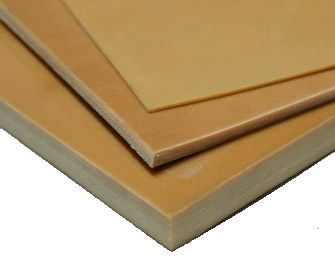|
|
Natural rubber sheets are durable and flexible materials commonly used to create flexible rubber parts for a wide range of applications whether it be industrial or residential. Natural rubber, vs synthetic rubber is an organic material that is created using harvested materials derived from plants. Due to its plant-based composition, natural rubber is an environmentally friendly, yet resilient, material. On the other hand, synthetic rubbers are man-made materials that are made from petroleum-derived chemicals. Because of their chemical composition, synthetic rubbers are known to have better physical and chemical properties than natural gum rubber, allowing them to be used in heavy-duty applications. Overall, both types of rubber are versatile materials used in a wide range of applications and settings.
What is Natural Rubber and Its Uses?
Natural rubber is an organic rubber variation harvested from the Hevea brasiliensis, or the rubber tree, that is commonly used in industrial, commercial, and residential applications. Natural rubber material is a plant-based rubber that derives from the sticky white latex material that is harvested from the rubber tree commonly found in South America and South Asia. Natural rubber manufacturers begin the production with a procedure called “tapping”, which is the process of creating diagonal incisions into the trunk of the Hevea brasiliensis tree to allow the liquid latex material to trickle out and collect in containers. This liquid latex material its then mixed with chemical coagulants and strengtheners before being vulcanized into solid natural rubber material (newworldencyclopedia.org). Due to its raw, plant-based composition, natural rubber, vs synthetic rubber, is considered an environmentally friendly material. Case in point, according to the American Society for Microbiology, “Microbial degradation of natural rubber has been investigated for 100 years. It became obvious that bacteria, as well as fungi, are capable of degrading rubber and the rubber biodegradation is a slow process” (aem.asm.org). Oftentimes, chemicals are added to prevent the material from deteriorating when exposed to damaging environmental factors that normally deteriorate natural rubber vs synthetic rubber materials.

|

|
Natural rubber material retains excellent physical and chemical properties and an operating temperature range of -20 to +170 degrees Fahrenheit. As an elastomer, natural rubber is highly tear resistant, allowing it to produce flexible rubber parts. Their tear strength and elasticity make natural rubber sheets ideal for creating industrial, commercial, and residential products, including wiper blades, seals, gaskets, noise dampening pads, and skirting. Additionally, natural rubber retains a naturally high coefficient of friction which allows it to remain a tacky and traction-enhancing material even when it is exposed to moisture. Natural rubber material offers long life in industrial settings not only due to its excellent tear strength, but also due to its chemical resistance properties. It is resistant to “most acids, salts, ammonia and alkalis chemicals” (engineersedge.com). Despite this, natural gum rubber is not suitable for applications involving extremely caustic chemicals, such as bleach. Therefore, natural rubber sheets and parts are better suited for light to medium-duty applications when the choice comes to natural rubber vs synthetic rubber.
(a) What is the Difference Between Natural Rubber and Synthetic Rubber?
The main difference between natural rubber and synthetic rubber is that natural rubber is an organic material that is harvested while synthetic rubbers are man-made materials made with a blend of chemical compounds. For instance, natural rubber material is made from materials harvested from plants whereas synthetic rubbers are made from materials derived from petroleum and natural gas (Britannica.com). Gum rubber is produced when natural rubber manufacturers harvest the liquid latex from the rubber tree, blend it with chemical strengtheners, and vulcanize it into a solid material. Its organic composition creates limitations for the material that synthetic rubber can surpass. Synthetic rubbers are any artificial elastomer that derives from petroleum byproducts. Like natural rubber material, synthetic rubbers are popular materials used in creating flexible rubber parts for industrial, commercial, and residential applications. Compared to natural gum rubber, synthetic rubbers are stronger, more resistant to caustic chemicals, has higher operating temperature ranges, and are better resistant to damaging environmental factors. For example, “Synthetic rubbers are superior to natural rubbers in two major respects, thermal stability and resistance to oils and related compounds. They are more resistant to oxidizing agents for example, such as oxygen and ozone which can reduce the life of products like tires” (Wikipedia.org). Due to their chemical compositions, synthetic rubbers are stronger and longer-lasting then natural rubber; however, both natural rubber material and synthetic rubber material are durable material for producing flexible rubber parts.

|

|
Natural rubber, vs synthetic rubber, is a natural, plant-based material that is made from the liquid latex harvested from the Hevea brasiliensis, or the rubber tree. Contrastingly, synthetic rubbers are artificial, man-made materials that are made from chemicals that derive from petroleum oil. Due to their difference in compositions, both natural rubber material and synthetic rubber material will retain varying properties. Synthetic rubber will be stronger, more chemically resistant, more thermally stable, and better resistant to environmental factors, including UV rays, ozone, oxygen, and moisture. Synthetic rubber sheets may be more durable than natural rubber sheets; however, natural rubber still retains excellent tear strength, moderate chemical resistance, and excellent flexibility. Despite their difference in compositions, both natural rubber material and synthetic rubber material are used to create durable and flexible rubber parts for industrial, commercial, and residential applications. Natural Rubber vs Synthetic Rubber
|
|
|